linux命令详解:pgrep命令
20.Linux进程管理
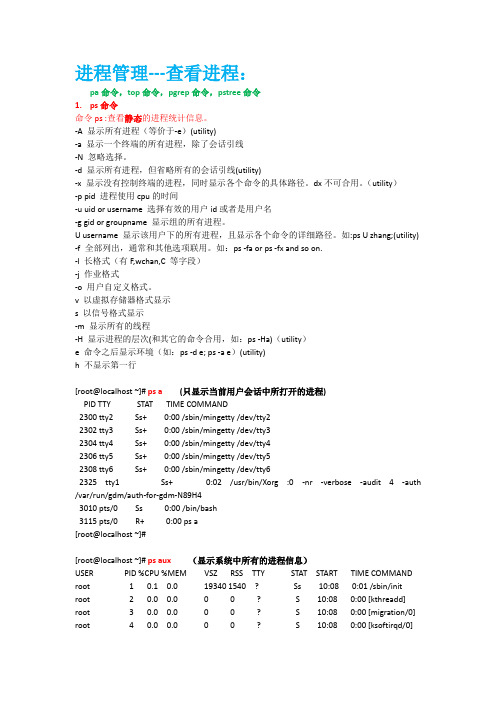
进程管理---查看进程:pa命令,top命令,pgrep命令,pstree命令1.ps命令命令ps :查看静态的进程统计信息。
-A 显示所有进程(等价于-e)(utility)-a 显示一个终端的所有进程,除了会话引线-N 忽略选择。
-d 显示所有进程,但省略所有的会话引线(utility)-x 显示没有控制终端的进程,同时显示各个命令的具体路径。
dx不可合用。
(utility)-p pid 进程使用cpu的时间-u uid or username 选择有效的用户id或者是用户名-g gid or groupname 显示组的所有进程。
U username 显示该用户下的所有进程,且显示各个命令的详细路径。
如:ps U zhang;(utility) -f 全部列出,通常和其他选项联用。
如:ps -fa or ps -fx and so on.-l 长格式(有F,wchan,C 等字段)-j 作业格式-o 用户自定义格式。
v 以虚拟存储器格式显示s 以信号格式显示-m 显示所有的线程-H 显示进程的层次(和其它的命令合用,如:ps -Ha)(utility)e 命令之后显示环境(如:ps -d e; ps -a e)(utility)h 不显示第一行[root@localhost ~]# ps a(只显示当前用户会话中所打开的进程)PID TTY STAT TIME COMMAND2300 tty2 Ss+ 0:00 /sbin/mingetty /dev/tty22302 tty3 Ss+ 0:00 /sbin/mingetty /dev/tty32304 tty4 Ss+ 0:00 /sbin/mingetty /dev/tty42306 tty5 Ss+ 0:00 /sbin/mingetty /dev/tty52308 tty6 Ss+ 0:00 /sbin/mingetty /dev/tty62325 tty1 Ss+ 0:02 /usr/bin/Xorg :0 -nr -verbose -audit 4 -auth /var/run/gdm/auth-for-gdm-N89H43010 pts/0 Ss 0:00 /bin/bash3115 pts/0 R+ 0:00 ps a[root@localhost ~]#[root@localhost ~]# ps aux(显示系统中所有的进程信息)USER PID %CPU %MEM VSZ RSS TTY STAT START TIME COMMAND root 1 0.1 0.0 19340 1540 ? Ss 10:08 0:01 /sbin/init root 2 0.0 0.0 0 0 ? S 10:08 0:00 [kthreadd] root 3 0.0 0.0 0 0 ? S 10:08 0:00 [migration/0] root 4 0.0 0.0 0 0 ? S 10:08 0:00 [ksoftirqd/0]USER------------启动该进程的用户名UID-------------用户ID(User ID)PID-------------进程ID(Process ID)PPID-----------父进程的进程ID(Parent Process id)SID-------------会话ID(Session id)%CPU--------------进程的cpu占用率%MEM---------------进程的内存占用率VSZ-------------------进程所使用的虚存的大小(Virtual Size)RSS-------------------进程使用的驻留集大小或者是实际内存的大小,Kbytes字节。
linuxgrep命令用法
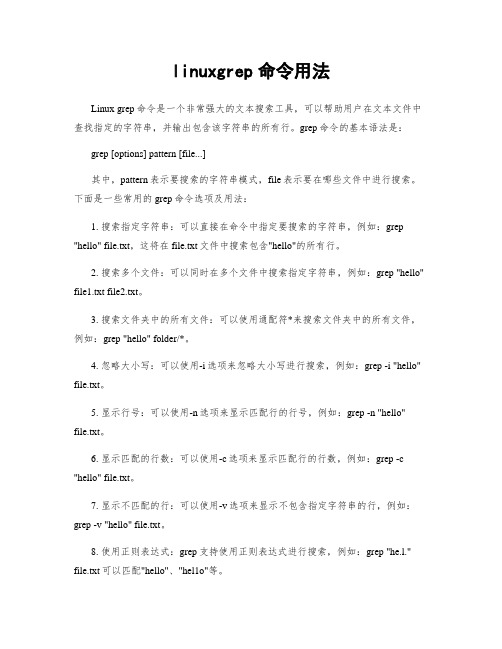
linuxgrep命令用法Linux grep命令是一个非常强大的文本搜索工具,可以帮助用户在文本文件中查找指定的字符串,并输出包含该字符串的所有行。
grep命令的基本语法是:grep [options] pattern [file...]其中,pattern表示要搜索的字符串模式,file表示要在哪些文件中进行搜索。
下面是一些常用的grep命令选项及用法:1. 搜索指定字符串:可以直接在命令中指定要搜索的字符串,例如:grep "hello" file.txt,这将在file.txt文件中搜索包含"hello"的所有行。
2. 搜索多个文件:可以同时在多个文件中搜索指定字符串,例如:grep "hello" file1.txt file2.txt。
3. 搜索文件夹中的所有文件:可以使用通配符*来搜索文件夹中的所有文件,例如:grep "hello" folder/*。
4. 忽略大小写:可以使用-i选项来忽略大小写进行搜索,例如:grep -i "hello" file.txt。
5. 显示行号:可以使用-n选项来显示匹配行的行号,例如:grep -n "hello" file.txt。
6. 显示匹配的行数:可以使用-c选项来显示匹配行的行数,例如:grep -c "hello" file.txt。
7. 显示不匹配的行:可以使用-v选项来显示不包含指定字符串的行,例如:grep -v "hello" file.txt。
8. 使用正则表达式:grep支持使用正则表达式进行搜索,例如:grep "he.l." file.txt可以匹配"hello"、"hel1o"等。
9. 递归搜索:可以使用-r选项来递归搜索文件夹中的所有文件,例如:grep -r "hello" folder。
linux批量删除进程与查看进程详解linux操作系统-电脑资料
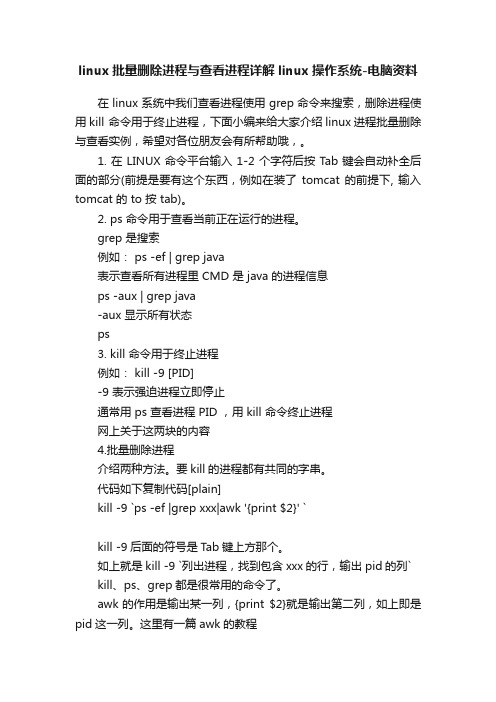
linux批量删除进程与查看进程详解linux操作系统-电脑资料在linux系统中我们查看进程使用grep命令来搜索,删除进程使用kill 命令用于终止进程,下面小编来给大家介绍linux进程批量删除与查看实例,希望对各位朋友会有所帮助哦,。
1. 在 LINUX 命令平台输入 1-2 个字符后按 Tab 键会自动补全后面的部分(前提是要有这个东西,例如在装了tomcat 的前提下, 输入tomcat 的 to 按 tab)。
2. ps 命令用于查看当前正在运行的进程。
grep 是搜索例如: ps -ef | grep java表示查看所有进程里 CMD 是 java 的进程信息ps -aux | grep java-aux 显示所有状态ps3. kill 命令用于终止进程例如: kill -9 [PID]-9 表示强迫进程立即停止通常用 ps 查看进程 PID ,用 kill 命令终止进程网上关于这两块的内容4.批量删除进程介绍两种方法。
要kill的进程都有共同的字串。
代码如下复制代码[plain]kill -9 `ps -ef |grep xxx|awk '{print $2}' `kill -9后面的符号是Tab键上方那个。
如上就是kill -9 `列出进程,找到包含xxx的行,输出pid的列` kill、ps、grep都是很常用的命令了。
awk的作用是输出某一列,{print $2}就是输出第二列,如上即是pid这一列。
这里有一篇awk的教程代码如下复制代码[plain]ps -ef | grep xxx | grep -v root | awk '{print $2}' | xargs kill -9grep -v这个参数的作用是排除某个字符。
所以这里排除了root 执行的命令。
之后也利用awk找到pid这一列。
最后的xargs是从标准输出获取参数并执行命令的程序,即从前面的命令获取输出作为参数来执行下一个命令。
Linux常用指令---grep(搜索过滤)
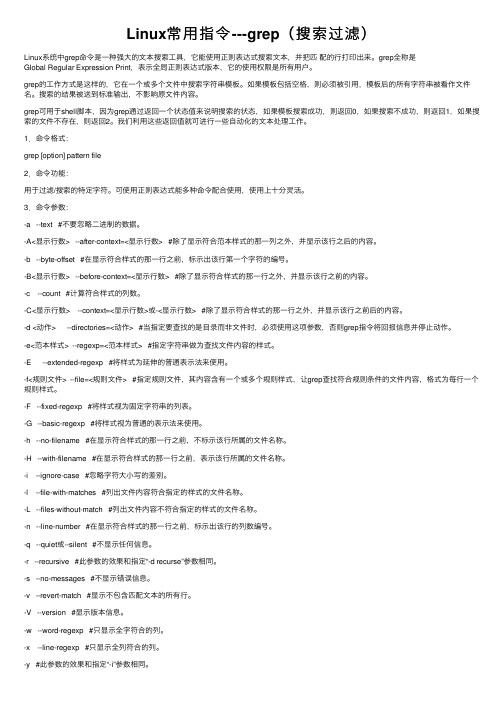
Linux常⽤指令---grep(搜索过滤)Linux系统中grep命令是⼀种强⼤的⽂本搜索⼯具,它能使⽤正则表达式搜索⽂本,并把匹配的⾏打印出来。
grep全称是Global Regular Expression Print,表⽰全局正则表达式版本,它的使⽤权限是所有⽤户。
grep的⼯作⽅式是这样的,它在⼀个或多个⽂件中搜索字符串模板。
如果模板包括空格,则必须被引⽤,模板后的所有字符串被看作⽂件名。
搜索的结果被送到标准输出,不影响原⽂件内容。
grep可⽤于shell脚本,因为grep通过返回⼀个状态值来说明搜索的状态,如果模板搜索成功,则返回0,如果搜索不成功,则返回1,如果搜索的⽂件不存在,则返回2。
我们利⽤这些返回值就可进⾏⼀些⾃动化的⽂本处理⼯作。
1.命令格式:grep [option] pattern file2.命令功能:⽤于过滤/搜索的特定字符。
可使⽤正则表达式能多种命令配合使⽤,使⽤上⼗分灵活。
3.命令参数:-a --text #不要忽略⼆进制的数据。
-A<显⽰⾏数> --after-context=<显⽰⾏数> #除了显⽰符合范本样式的那⼀列之外,并显⽰该⾏之后的内容。
-b --byte-offset #在显⽰符合样式的那⼀⾏之前,标⽰出该⾏第⼀个字符的编号。
-B<显⽰⾏数> --before-context=<显⽰⾏数> #除了显⽰符合样式的那⼀⾏之外,并显⽰该⾏之前的内容。
-c --count #计算符合样式的列数。
-C<显⽰⾏数> --context=<显⽰⾏数>或-<显⽰⾏数> #除了显⽰符合样式的那⼀⾏之外,并显⽰该⾏之前后的内容。
-d <动作> --directories=<动作> #当指定要查找的是⽬录⽽⾮⽂件时,必须使⽤这项参数,否则grep指令将回报信息并停⽌动作。
Linux命令高级技巧使用kill和pkill终止进程
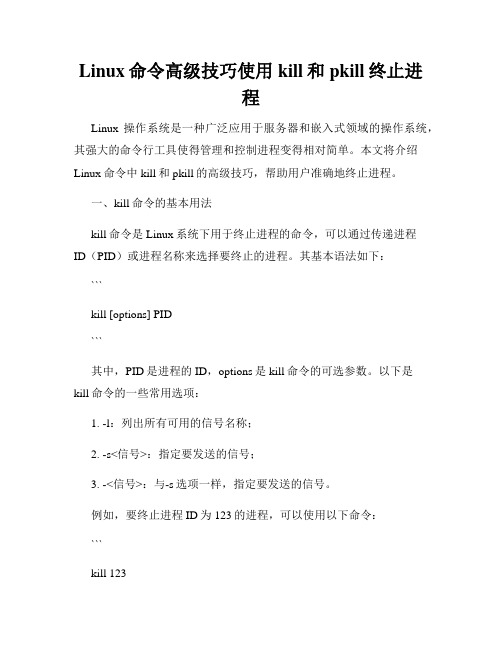
Linux命令高级技巧使用kill和pkill终止进程Linux操作系统是一种广泛应用于服务器和嵌入式领域的操作系统,其强大的命令行工具使得管理和控制进程变得相对简单。
本文将介绍Linux命令中kill和pkill的高级技巧,帮助用户准确地终止进程。
一、kill命令的基本用法kill命令是Linux系统下用于终止进程的命令,可以通过传递进程ID(PID)或进程名称来选择要终止的进程。
其基本语法如下:```kill [options] PID```其中,PID是进程的ID,options是kill命令的可选参数。
以下是kill命令的一些常用选项:1. -l:列出所有可用的信号名称;2. -s<信号>:指定要发送的信号;3. -<信号>:与-s选项一样,指定要发送的信号。
例如,要终止进程ID为123的进程,可以使用以下命令:```kill 123```二、kill命令的高级技巧1. 使用信号终止进程在Linux中,kill命令默认使用的是SIGTERM信号(编号为15),它会请求进程正常终止。
如果进程未能正常终止,可以尝试使用SIGKILL信号(编号为9),该信号会立即中止进程,不给予进程任何处理机会。
可以通过以下命令发送SIGKILL信号终止进程:```kill -9 PID```请注意,使用SIGKILL信号强制终止进程可能会导致数据丢失或系统不稳定,请谨慎使用。
2. 使用killall命令终止进程killall命令可以根据进程名称终止多个进程,其基本语法如下:```killall [options] 进程名```以下是killall命令的一些常用选项:1. -i:在终止进程之前进行交互确认;2. -s<信号>:指定要发送的信号,默认为SIGTERM;3. --help:显示killall命令的帮助信息。
例如,要终止所有名为"example"的进程,可以使用以下命令:```killall example```三、pkill命令的基本用法pkill命令也可以根据进程名称终止进程,但与killall命令相比,pkill命令更加灵活。
linux grep命令详解

简介grep (global search regular expression(RE) and print out the line,全面搜索正则表达式并把行打印出来)是一种强大的文本搜索工具,它能使用正则表达式搜索文本,并把匹配的行打印出来。
Unix的grep家族包括grep、egrep和fgrep。
egrep和fgrep的命令只跟grep有很小不同。
egrep 是grep的扩展,支持更多的re元字符,fgrep就是fixed grep或fast grep,它们把所有的字母都看作单词,也就是说,正则表达式中的元字符表示回其自身的字面意义,不再特殊。
linux使用GNU 版本的grep。
它功能更强,可以通过-G、-E、-F命令行选项来使用egrep和fgrep的功能。
grep常用用法[root@www ~]# grep [-acinv] [--color=auto] '搜寻字符串' filename选项与参数:-a :将 binary 文件以 text 文件的方式搜寻数据-c :计算找到'搜寻字符串'的次数-i :忽略大小写的不同,所以大小写视为相同-n :顺便输出行号-v :反向选择,亦即显示出没有'搜寻字符串'内容的那一行!--color=auto :可以将找到的关键词部分加上颜色的显示喔!将/etc/passwd,有出现root 的行取出来# grep root /etc/passwdroot:x:0:0:root:/root:/bin/bashoperator:x:11:0:operator:/root:/sbin/nologin或# cat /etc/passwd | grep rootroot:x:0:0:root:/root:/bin/bashoperator:x:11:0:operator:/root:/sbin/nologin将/etc/passwd,有出现root 的行取出来,同时显示这些行在/etc/passwd的行号# grep -n root /etc/passwd1:root:x:0:0:root:/root:/bin/bash30:operator:x:11:0:operator:/root:/sbin/nologin在关键字的显示方面,grep 可以使用--color=auto 来将关键字部分使用颜色显示。
Linux十个常用命令
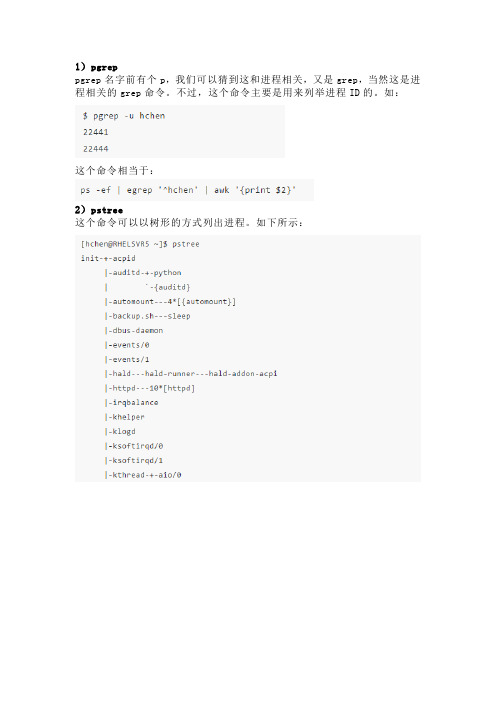
1)pgreppgrep名字前有个p,我们可以猜到这和进程相关,又是grep,当然这是进程相关的grep命令。
不过,这个命令主要是用来列举进程ID的。
如:这个命令相当于:2)pstree这个命令可以以树形的方式列出进程。
如下所示:3)bc这个命令主要是做一个精度比较高的数学运算的。
比如开平方根等。
下面是一个我们利用bc命令写的一个脚本(文件名:sqrt)于是,我们可以这样使用这个脚本进行平方根运算:4)split如果你有一个很大的文件,你想把其分割成一些小的文件,那么这个命令就是干这件事的了。
文件合并只需要使用简单的合并就行了,如:5)nlnl命令其它和cat命令很像,只不过它会打上行号。
如下所示:6)mkfifo熟悉Unix的人都应该知道这个是一个创建有名管道的系统调用或命令。
平时,我们在命令行上使用竖线“|”把命令串起来是使用无命管道。
而我们使用mkfifo则使用的是有名管道。
下面是示例:下面是创建一个有名管道:然后,我们在一个shell中运行如下命令,这个命令不会返回,除非有人从这个有名管道中把信息读走。
我们在另一个命令窗口中读取这个管道中的信息:(其会导致上一个命令返回)7)ldd这个命令可以知道你的一个可执行文件所使用了动态链接库。
如:8)col这个命令可以让你把man文件转成纯文本文件。
如下示例:9)xmlwf这个命令可以让你检查一下一个XML文档是否是所有的tag都是正常的。
如:10)lsof可以列出打开了的文件。
Linux命令高级技巧使用ps和pgrep查看和管理进程
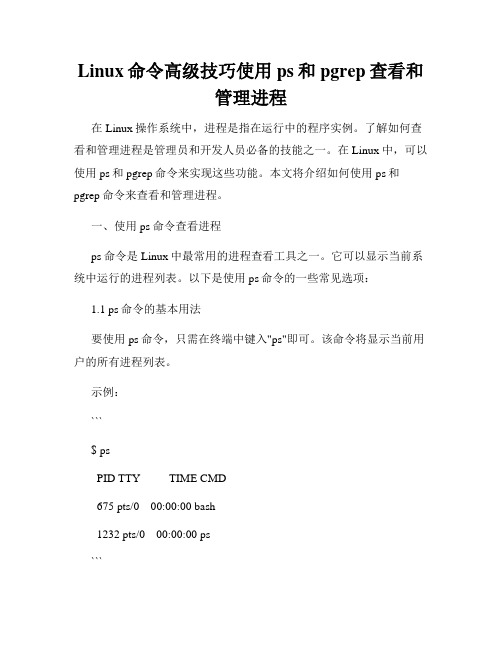
Linux命令高级技巧使用ps和pgrep查看和管理进程在Linux操作系统中,进程是指在运行中的程序实例。
了解如何查看和管理进程是管理员和开发人员必备的技能之一。
在Linux中,可以使用ps和pgrep命令来实现这些功能。
本文将介绍如何使用ps和pgrep命令来查看和管理进程。
一、使用ps命令查看进程ps命令是Linux中最常用的进程查看工具之一。
它可以显示当前系统中运行的进程列表。
以下是使用ps命令的一些常见选项:1.1 ps命令的基本用法要使用ps命令,只需在终端中键入"ps"即可。
该命令将显示当前用户的所有进程列表。
示例:```$ psPID TTY TIME CMD675 pts/0 00:00:00 bash1232 pts/0 00:00:00 ps```上述示例输出了三列信息。
第一列是进程的PID(进程ID),第二列是终端的TTY,第三列是进程的命令。
1.2 显示所有用户的进程默认情况下,ps命令只显示当前用户的进程。
如果要查看所有用户的进程,可以使用"-e"选项。
示例:```$ ps -ePID TTY TIME CMD1 ? 00:00:03 systemd2 ? 00:00:00 kthreadd3 ? 00:00:00 ksoftirqd...```1.3 显示进程的详细信息使用"-f"选项可以显示进程的详细信息,包括进程的UID(用户ID)、PPID(父进程ID)、C(CPU利用率)、STIME(启动时间)等。
示例:```$ ps -fUID PID PPID C STIME TTY TIME CMDroot 1 0 0 08:36 ? 00:00:03 /sbin/initroot 2 0 0 08:36 ? 00:00:00 [kthreadd]root 3 2 0 08:36 ? 00:00:00 [ksoftirqd/0]...```1.4 根据进程名进行过滤使用"-C"选项可以根据进程名进行过滤,只显示符合条件的进程。
linux操作
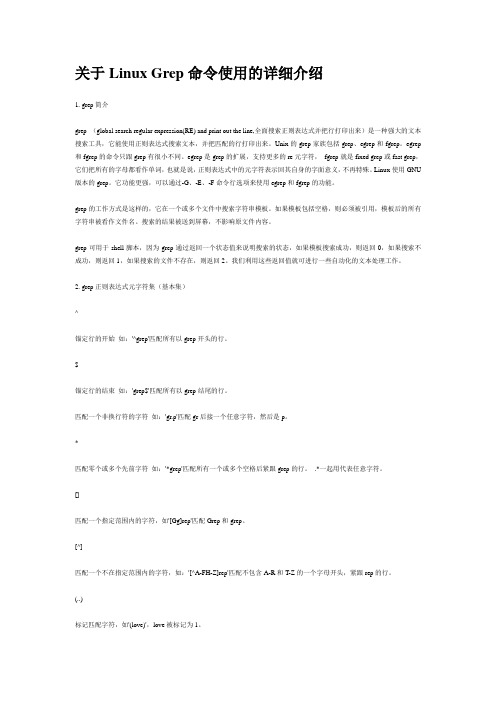
关于Linux Grep命令使用的详细介绍1. grep简介grep (global search regular expression(RE) and print out the line,全面搜索正则表达式并把行打印出来)是一种强大的文本搜索工具,它能使用正则表达式搜索文本,并把匹配的行打印出来。
Unix的grep家族包括grep、egrep和fgrep。
egrep 和fgrep的命令只跟grep有很小不同。
egrep是grep的扩展,支持更多的re元字符,fgrep就是fixed grep或fast grep,它们把所有的字母都看作单词,也就是说,正则表达式中的元字符表示回其自身的字面意义,不再特殊。
Linux使用GNU 版本的grep。
它功能更强,可以通过-G、-E、-F命令行选项来使用egrep和fgrep的功能。
grep的工作方式是这样的,它在一个或多个文件中搜索字符串模板。
如果模板包括空格,则必须被引用,模板后的所有字符串被看作文件名。
搜索的结果被送到屏幕,不影响原文件内容。
grep可用于shell脚本,因为grep通过返回一个状态值来说明搜索的状态,如果模板搜索成功,则返回0,如果搜索不成功,则返回1,如果搜索的文件不存在,则返回2。
我们利用这些返回值就可进行一些自动化的文本处理工作。
2. grep正则表达式元字符集(基本集)^锚定行的开始如:'^grep'匹配所有以grep开头的行。
$锚定行的结束如:'grep$'匹配所有以grep结尾的行。
匹配一个非换行符的字符如:'gr.p'匹配gr后接一个任意字符,然后是p。
*匹配零个或多个先前字符如:'*grep'匹配所有一个或多个空格后紧跟grep的行。
.*一起用代表任意字符。
[]匹配一个指定范围内的字符,如'[Gg]rep'匹配Grep和grep。
[^]匹配一个不在指定范围内的字符,如:'[^A-FH-Z]rep'匹配不包含A-R和T-Z的一个字母开头,紧跟rep的行。
linux grep命令详解

linux grep命令详解简介grep (global search regular expression(RE) and print out the line,全面搜索正则表达式并把行打印出来)是一种强大的文本搜索工具,它能使用正则表达式搜索文本,并把匹配的行打印出来。
Unix的grep家族包括grep、egrep和fgrep。
egrep和fgrep的命令只跟grep有很小不同。
egrep是grep的扩展,支持更多的re元字符,fgrep就是fixed grep或fast grep,它们把所有的字母都看作单词,也就是说,正则表达式中的元字符表示回其自身的字面意义,不再特殊。
linux使用GNU版本的grep。
它功能更强,可以通过-G、-E、-F命令行选项来使用egrep和fgrep的功能。
grep常用用法[root@www ~]# grep [-acinv] [--color=auto] '搜寻字符串' filename选项与参数:-a :将binary 文件以text 文件的方式搜寻数据-c :计算找到'搜寻字符串'的次数-i:忽略大小写的不同,所以大小写视为相同-n :顺便输出行号-v :反向选择,亦即显示出没有'搜寻字符串'内容的那一行!--color=auto :可以将找到的关键词部分加上颜色的显示喔!将/etc/passwd,有出现root 的行取出来# grep root /etc/passwdroot:x:0:0:root:/root:/bin/bashoperator:x:11:0:operator:/root:/sbin/nologin或# cat /etc/passwd | grep rootroot:x:0:0:root:/root:/bin/bashoperator:x:11:0:operator:/root:/sbin/nologin将/etc/passwd,有出现root 的行取出来,同时显示这些行在/etc/passwd的行号# grep -n root /etc/passwd1:root:x:0:0:root:/root:/bin/bash30:operator:x:11:0:operator:/root:/sbin/nologin在关键字的显示方面,grep可以使用--color=auto 来将关键字部分使用颜色显示。
grep的用法

Grep的用法QUOTE:原帖由"网中人" 发表:比方以grep 来说, 在Linux 上你可找到grep, egrep, fgrep 这几个程序, 其差异大致如下:* grep:传统的grep 程序, 在没有参数的情况下, 只输出符合RE 字符串之句子. 常见参数如下:-v: 逆反模示, 只输出"不含" RE 字符串之句子.-r: 递归模式, 可同时处理所有层级子目录里的文件.-q: 静默模式, 不输出任何结果(stderr 除外. 常用以获取return value, 符合为true, 否则为false .)-i: 忽略大小写.-w: 整词比对, 类似\<word\> .-n: 同时输出行号.-c: 只输出符合比对的行数.-l: 只输出符合比对的文件名称.-o: 只输出符合RE 的字符串. (gnu 新版独有, 不见得所有版本都支持.)-E: 切换为egrep .* egrep:为grep 的扩充版本, 改良了许多传统grep 不能或不便的操作. 比方说:- grep 之下不支持? 与+ 这两种modifier, 但egrep 则可.- grep 不支持a|b 或(abc|xyz) 这类"或一"比对, 但egrep 则可.- grep 在处理{n,m} 时, 需用\{ 与\} 处理, 但egrep 则不需.诸如此类的... 我个人会建议能用egrep 就不用grep 啦... ^_^* fgrep:不作RE 处理, 表达式仅作一般字符串处理, 所有meta 均失去功能.g r e p一般格式为:][ - ] CODE:grep [选项]基本正则表达式[文件]这里基本正则表达式可为字符串。
单引号双引号在g r e p命令中输入字符串参数时,最好将其用双引号括起来。
在调用模式匹配时,应使用单引号。
例如:“m y s t r i n g”。
linux rep用法

在Linux中,rep是一个用于替换文本的命令。
它的基本用法如下:
rep 'pattern' 'replacement' file
其中,'pattern'是要被替换的文本模式,'replacement'是替换后的文本,file是要进行替换的文件名。
例如,假设有一个名为file.txt的文件,内容如下:
Hello, world!
我们想将其中的"world"替换为"Linux",可以使用以下命令:
rep 'world' 'Linux' file.txt
执行后,file.txt的内容将变为:
Hello, Linux!
rep命令还支持一些选项,例如:
- i:忽略大小写进行替换
- g:全局替换,替换所有匹配的文本
- w:只替换整个单词匹配的文本
可以根据需要使用这些选项来进行更精确的替换操作。
linux中pipe命令的用法
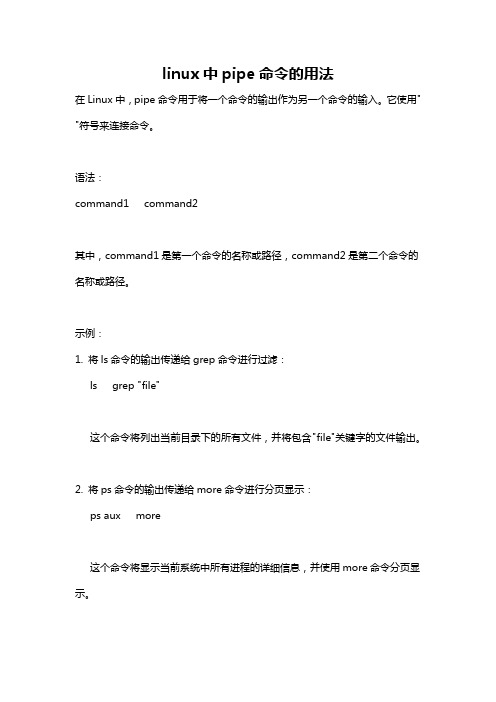
linux中pipe命令的用法
在Linux中,pipe命令用于将一个命令的输出作为另一个命令的输入。
它使用" "符号来连接命令。
语法:
command1 command2
其中,command1是第一个命令的名称或路径,command2是第二个命令的名称或路径。
示例:
1. 将ls命令的输出传递给grep命令进行过滤:
ls grep "file"
这个命令将列出当前目录下的所有文件,并将包含"file"关键字的文件输出。
2. 将ps命令的输出传递给more命令进行分页显示:
ps aux more
这个命令将显示当前系统中所有进程的详细信息,并使用more命令分页显示。
3. 将cat命令的输出传递给grep命令进行过滤,并将结果输出到文件:
cat file.txt grep "keyword" > output.txt
这个命令将读取file.txt文件的内容,将包含"keyword"关键字的行过滤出来,并将结果保存到output.txt文件中。
注意事项:
- 使用pipe命令时,第一个命令的输出必须是第二个命令所需的输入格式。
- 可以使用多个pipe命令连接多个命令,例如:"command1 command2 command3"。
- pipe命令也可以与其他命令结合使用,例如使用重定向符号将结果输出到文件:"command command2 > file.txt"。
Linux基础命令中,进程相关命令有哪些?

Linux基础命令中,进程相关命令有哪些?
随着互联网技术的发展,Linux逐步成为了较为热门的职业岗位技术,受到越来越多的企业和个人的喜爱。
互联网市场对Linux运维的需求也在增加。
Linux命令是Linux运维技能的基础,想要学好Linux 技术,一定要将常用的Linux命令牢记于心。
Linux基础命令中,进程相关命令有哪些?
Linux进程基础命令有哪些?
ps:查看进程
ps命令用于列出执行ps命令的那个时刻的进程快照,就像用手机给进程照了一张照片。
如果想要动态地显示进程的信息,就需要使用top命令,该命令类似于把手机切换成录像模式。
pstree:显示进程状态树
pstree命令以树形结构显示进程和进程之间的关系。
pgrep:查找匹配条件的进程
pgrep命令可以查找匹配条件的进程号。
kill:终止进程
kill命令能够终止你希望停止的进程。
killall:通过进程名终止进程
使用kill命令终止进程还需要先获取进程的pid进程号,这个过程有点繁琐,而使用killall命令就可以直接用“kllall进程名”这种形式终止进程。
pkill:通过进程名终止进程
pkill命令可通过进程名终止指定的进程。
使用kllall终止进程需要连续执行几次,而pkill可以杀死指定进程及其所有子进程。
如何在Linux终端中查找和终止进程
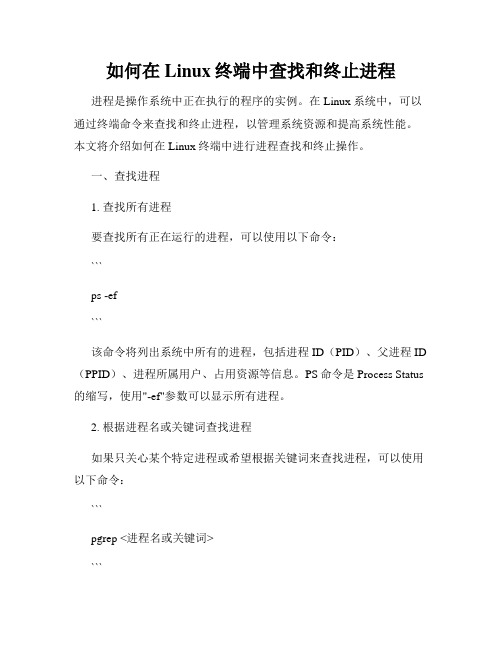
如何在Linux终端中查找和终止进程进程是操作系统中正在执行的程序的实例。
在Linux系统中,可以通过终端命令来查找和终止进程,以管理系统资源和提高系统性能。
本文将介绍如何在Linux终端中进行进程查找和终止操作。
一、查找进程1. 查找所有进程要查找所有正在运行的进程,可以使用以下命令:```ps -ef```该命令将列出系统中所有的进程,包括进程ID(PID)、父进程ID (PPID)、进程所属用户、占用资源等信息。
PS命令是Process Status 的缩写,使用"-ef"参数可以显示所有进程。
2. 根据进程名或关键词查找进程如果只关心某个特定进程或希望根据关键词来查找进程,可以使用以下命令:```pgrep <进程名或关键词>```例如,要查找名为"firefox"的进程,可以运行以下命令:```pgrep firefox```该命令将返回匹配的进程ID。
3. 查找具体进程信息要查看特定进程的详细信息,可以使用以下命令:```ps -p <进程ID>```例如,要查看进程ID为1234的详细信息,可以运行以下命令:```ps -p 1234```该命令将显示进程ID为1234的所有信息。
二、终止进程1. 使用kill命令终止进程要终止一个或多个进程,可以使用kill命令。
该命令根据进程ID终止指定进程。
```kill <进程ID>```例如,要终止进程ID为1234的进程,可以运行以下命令:```kill 1234```2. 使用killall命令终止进程除了使用进程ID来终止进程,还可以使用进程名来终止进程。
killall命令可以根据进程名来终止所有匹配的进程。
```killall <进程名>```例如,要终止名为"firefox"的进程,可以运行以下命令:```killall firefox```请注意,使用killall命令将终止匹配进程名的所有进程,请谨慎使用。
【IT专家】linux的瑞士军刀:lsof-fuser-pkill-pgrep
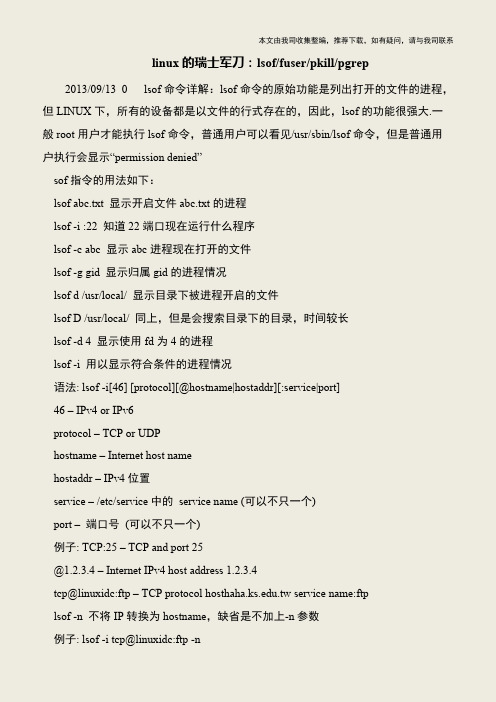
本文由我司收集整编,推荐下载,如有疑问,请与我司联系linux的瑞士军刀:lsof/fuser/pkill/pgrep2013/09/13 0 lsof命令详解:lsof命令的原始功能是列出打开的文件的进程,但LINUX下,所有的设备都是以文件的行式存在的,因此,lsof的功能很强大.一般root用户才能执行lsof命令,普通用户可以看见/usr/sbin/lsof命令,但是普通用户执行会显示“permission denied” sof指令的用法如下: lsof abc.txt 显示开启文件abc.txt的进程 lsof -i :22 知道22端口现在运行什么程序 lsof -c abc 显示abc进程现在打开的文件 lsof -g gid 显示归属gid的进程情况 lsof d /usr/local/ 显示目录下被进程开启的文件 lsof D /usr/local/ 同上,但是会搜索目录下的目录,时间较长 lsof -d 4 显示使用fd为4的进程 lsof -i 用以显示符合条件的进程情况 语法: lsof -i[46] [protocol][@hostname|hostaddr][:service|port] 46 – IPv4 or IPv6 protocol – TCP or UDP hostname – Internet host name hostaddr – IPv4位置 service – /etc/service中的service name (可以不只一个) port – 端口号(可以不只一个) 例子: TCP:25 – TCP and port 25 @1.2.3.4 – Internet IPv4 host address 1.2.3.4 tcp@linuxidc:ftp – TCP protocol .tw service name:ftp lsof -n 不将IP转换为hostname,缺省是不加上-n参数 例子: lsof -i tcp@linuxidc:ftp -n。
Linux的pkill和pgrep命令详解

Linux的pkill和pgrep命令详解Linux的pkill和pgrep命令详解名称pgrep, pkill – 查找或者发信号给进程通过名称和其它属性。
语法pgrep [-flvx] [-n | -o] [-d delim] [-P ppidlist] [-g pgrplist] [-s sidlist] [-u euidlist] [-U uidlist] [-G gidlist] [-J projidlist] [-t termlist] [-T taskidlist] [-c ctidlist] [-z zoneidlist] [pattern]pkill [-signal] [-fvx] [-n | -o] [-P ppidlist] [-g pgrplist] [-s sidlist] [-u euidlist] [-U uidlist] [-G gidlist] [-J projidlist] [-t termlist] [-T taskidlist] [-c ctidlist] [-z zoneidlist] [pattern]说明pgrep程序检查在系统的中活动进程,报告进程属性匹配命令⾏上指定条件的进程的ID。
每⼀个进程ID以⼀个⼗进制数表⽰,通过⼀个分割字符串和下⼀个ID分开,默认的分割字符串是⼀个新⾏。
对于每个属性选项,⽤户可以在命令⾏上指定⼀个以逗号分割的可能值的集合。
例如,pgrep -G other,daemon匹配真实组ID是other或者是daemon的进程。
如果多个条件被指派,这些匹配条件按逻辑与”AND”规则运算。
例如,pgrep -G other,daemon -U root,daemon匹配进程它的属性是:(真实的组ID是other或者是daemon) 与 (真实的⽤户ID是root或者是daemon)pkill函数和pgrep相同,除了匹配的进程被信号通知就像⽤kill(1)替代了pgrep的进程ID的输出。
linux命令详解:pgrep命令
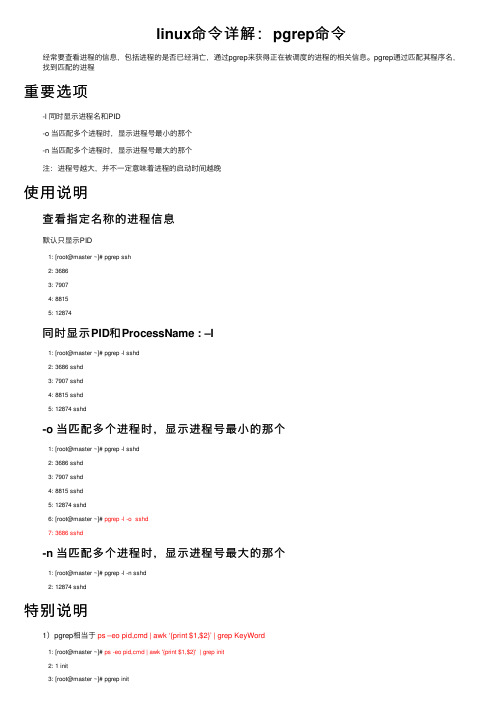
linux命令详解:pgrep命令经常要查看进程的信息,包括进程的是否已经消亡,通过pgrep来获得正在被调度的进程的相关信息。
pgrep通过匹配其程序名,找到匹配的进程重要选项-l 同时显⽰进程名和PID-o 当匹配多个进程时,显⽰进程号最⼩的那个-n 当匹配多个进程时,显⽰进程号最⼤的那个注:进程号越⼤,并不⼀定意味着进程的启动时间越晚使⽤说明查看指定名称的进程信息默认只显⽰PID1: [root@master ~]# pgrep ssh2: 36863: 79074: 88155: 12874同时显⽰PID和ProcessName : –l1: [root@master ~]# pgrep -l sshd2: 3686 sshd3: 7907 sshd4: 8815 sshd5: 12874 sshd-o 当匹配多个进程时,显⽰进程号最⼩的那个1: [root@master ~]# pgrep -l sshd2: 3686 sshd3: 7907 sshd4: 8815 sshd5: 12874 sshd6: [root@master ~]# pgrep -l -o sshd7: 3686 sshd-n 当匹配多个进程时,显⽰进程号最⼤的那个1: [root@master ~]# pgrep -l -n sshd2: 12874 sshd特别说明1)pgrep相当于ps –eo pid,cmd | awk ‘{print $1,$2}’ | grep KeyWord1: [root@master ~]# ps -eo pid,cmd | awk '{print $1,$2}' | grep init2: 1 init3: [root@master ~]# pgrep init4: 12)如1),pgrep查找的是程序名,不包括其参数如下,参数⾥包括要查找的参数,⽽程序名中不包括,所有没查找到。
Linux之grep和egrep命令总结

Linux之grep和egrep命令总结grep / egrep语法: grep [-cinvABC] 'word' filename-c :打印符合要求的行数-i :忽略大小写-n :在输出符合要求的行的同时连同行号一起输出-v :打印不符合要求的行-A :后跟一个数字(有无空格都可以),例如A2则表示打印符合要求的行以及下面两行-B :后跟一个数字,例如B2 则表示打印符合要求的行以及上面两行-C :后跟一个数字,例如C2 则表示打印符合要求的行以及上下各两行把包含‘halt’ 的行以及这行下面的两行都打印出。
[root@localhost ~]# grep -A2 'halt' /etc/passwdhalt:x:7:0:halt:/sbin:/sbin/haltmail:x:8:12:mail:/var/spool/mail:/sbin/nologinuucp:x:10:14:uucp:/var/spool/uucp:/sbin/nologin把包含‘halt’ 的行以及这行上面的两行都打印出。
[root@localhost ~]# grep -B2 'halt' /etc/passwd sync:x:5:0:sync:/sbin:/bin/syncshutdown:x:6:0:shutdown:/sbin:/sbin/shutdownhalt:x:7:0:halt:/sbin:/sbin/halt把包含‘halt’ 的行以及这行上面和下面的各两行都打印出。
[root@localhost ~]# grep -C2 'halt' /etc/passwd sync:x:5:0:sync:/sbin:/bin/syncshutdown:x:6:0:shutdown:/sbin:/sbin/shutdownhalt:x:7:0:halt:/sbin:/sbin/haltmail:x:8:12:mail:/var/spool/mail:/sbin/nologinuucp:x:10:14:uucp:/var/spool/uucp:/sbin/nologin过滤出带有某个关键词的行并输出行号[root@localhost ~]# grep -n 'root' /etc/passwd1:root:x:0:0:root:/root:/bin/bash11:operator:x:11:0:operator:/root:/sbin/nologin过滤不带有某个关键词的行,并输出行号[root@localhost ~]# grep -nv 'nologin' /etc/passwd1:root:x:0:0:root:/root:/bin/bash6:sync:x:5:0:sync:/sbin:/bin/sync7:shutdown:x:6:0:shutdown:/sbin:/sbin/shutdown8:halt:x:7:0:halt:/sbin:/sbin/halt26:test:x:511:511::/home/test:/bin/bash27:test1:x:512:511::/home/test1:/bin/bash过滤出所有包含数字的行[root@localhost ~]# grep '[0-9]' /etc/inittab# upstart works, see init(5), init(8), and initctl(8).# 0 - halt (Do NOT set initdefault to this)# 1 - Single user mode# 2 - Multiuser, without NFS (The same as 3, if you do not have networking)# 3 - Full multiuser mode# 4 - unused# 5 - X11# 6 - reboot (Do NOT set initdefault to this)id:3:initdefault:过滤出所有不包含数字的行[root@localhost ~]# grep -v '[0-9]' /etc/inittab# inittab is only used by upstart for the default runlevel.# ADDING OTHER CONFIGURATION HERE WILL HAVE NO EFFECT ON YOUR SYSTEM.## System initialization is started by /etc/init/rcS.conf## Individual runlevels are started by /etc/init/rc.conf## Ctrl-Alt-Delete is handled by /etc/init/control-alt-delete.conf## Terminal gettys are handled by /etc/init/tty.conf and /etc/init/serial.conf,# with configuration in /etc/sysconfig/init.## For information on how to write upstart event handlers, or how## Default runlevel. The runlevels used are:#把所有以‘#’ 开头的行去除[root@localhost ~]# grep -v '^#' /etc/inittabid:3:initdefault:去除所有空行和以‘#’ 开头的行[root@localhost ~]# grep -v '^#' /etc/crontab |grep -v '^$' SHELL=/bin/bashPATH=/sbin:/bin:/usr/sbin:/usr/binMAILTO=rootHOME=/在正则表达式中,“^” 表示行的开始,“$” 表示行的结尾,那么空行则可以用“^$” 表示,如何打印出不以英文字母开头的行呢?[root@localhost ~]# vim test.txt[root@localhost ~]# cat test.txt123abc456abc2323#laksdjfAlllllllll先在test.txt中写几行字符串,用来做实验。
- 1、下载文档前请自行甄别文档内容的完整性,平台不提供额外的编辑、内容补充、找答案等附加服务。
- 2、"仅部分预览"的文档,不可在线预览部分如存在完整性等问题,可反馈申请退款(可完整预览的文档不适用该条件!)。
- 3、如文档侵犯您的权益,请联系客服反馈,我们会尽快为您处理(人工客服工作时间:9:00-18:30)。
linux命令详解:pgrep
前言
经常要查看进程的信息,包括进程的是否已经消亡,通过pgrep来获得正在被调度的进程的相关信息。
pgrep通过匹配其程序名,找到匹配的进程
重要选项
-l 同时显示进程名和PID
-o 当匹配多个进程时,显示进程号最小的那个
-n 当匹配多个进程时,显示进程号最大的那个
注:进程号越大,并不一定意味着进程的启动时间越晚
使用说明
查看指定名称的进程信息
默认只显示PID
1: [root@master ~]# pgrep ssh
2: 3686
3: 7907
4: 8815
5: 12874
同时显示PID和ProcessName : –l
1: [root@master ~]# pgrep -l sshd
2: 3686 sshd
3: 7907 sshd
4: 8815 sshd
5: 12874 sshd
-o 当匹配多个进程时,显示进程号最小的那个
1: [root@master ~]# pgrep -l sshd
2: 3686 sshd
3: 7907 sshd
4: 8815 sshd
5: 12874 sshd
6: [root@master ~]# pgrep -l -o sshd
7: 3686 sshd
-n 当匹配多个进程时,显示进程号最大的那个
1: [root@master ~]# pgrep -l -n sshd
2: 12874 sshd
特别说明
1)pgrep相当于ps –eo pid,cmd | awk ‘{print $1,$2}’ | grep KeyWord
1: [root@master ~]# ps -eo pid,cmd | awk '{print $1,$2}' | grep init
2: 1 init
3: [root@master ~]# pgrep init
4: 1
2)如1),pgrep查找的是程序名,不包括其参数
如下,参数里包括要查找的参数,而程序名中不包括,所有没查找到。
1: [root@master ~]# ps axu | grep name
2: root 13298 0.0 0.3 5436 1000 pts/4 S 05:52 0:00 sh name.sh
3: root 13313 0.0 0.2 4876 672 pts/4 R+ 05:53 0:00 grep name
4: [root@master ~]# pgrep name
5: [root@master ~]#
总结
pgrep命令用来查找进程的信息,通常会和kill命令来连用,在指定条件下kill问题进程。
